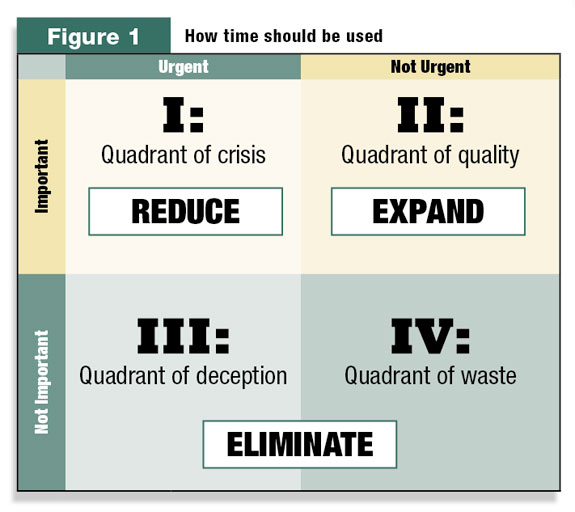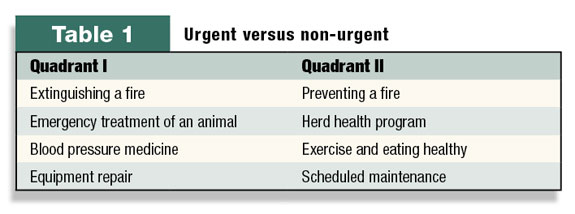How many of the following statements apply to you and your farm? • Working as hard as you can but always one step behind. • Frequently caught between work and personal/family expectations and obligations. • Often cannot find time for things you know are important. • Constantly focused on crises and emergencies. • Rarely have time to think and plan ahead. • Not able to implement what you already know.
Every one of us has felt this way on particularly stressful days. The challenge is to make certain that those days are rare.
When we think about managing our time we tend to think about time. That is the wrong approach because time management is not really about time. Time management is about priorities. Setting priorities that enable us to spend our time on the most valuable activities is the key to effectively using time and to success as a manager and leader.

Figure 1 , popularized by Stephen Covey in Seven Habits of Highly Effective People , provides the framework for discussing how each of us can better use our time.
In this diagram the two dimensions of urgent/not urgent and important/not important combine to make four quadrants. For time management, the diagram has two important implications:
1. Quadrants III and IV are both not important and thus activities that fall in these quadrants should be minimized and eliminated.
2. Quadrants I and II both contain important tasks and activities. In quadrant I these tasks and activities are also urgent and thus this quadrant is called the quadrant of crisis. In Quadrant II the tasks and activities are important but have not yet become urgent providing time to focus on them, thus the title quadrant of quality.
Reducing and eliminating tasks and activities that fall in Quadrants III and IV is important. The focus of this article, however, is answering three questions about quadrant II:

Why is Quadrant II crucial to my success as a leader and manager?
Table 1 compares some Quadrant I and Quadrant II activities for various nonfarm and farm examples.
Note that the Quadrant I activities are urgent and that activities and tasks in that quadrant cannot be completely eliminated. The value of the Quadrant II activities is that they reduce the frequency of Quadrant I activities and tasks. These Quadrant I activities and tasks are often costly and in business terms do not maximize profits.
Quadrant II is crucial to success as a leader and manager because time spent here results in greater planning and better problem solving. Quadrant II is referred to as the quadrant of quality because this is where there is time to develop, implement and continuously improve quality processes.
How do I find more Quadrant II time?
This of course is the $64,000 question. Reallocating your time to spend more time in Quadrant II is not easy, but it is both valuable to your farm business and rewarding to you as it reduces your stress level.
I encourage managers to develop structures and habits to increase both formal and informal Quadrant II time. Formal Quadrant II time is an established time – an hour a day or a couple of two-hour blocks a week – where you focus only on Quadrant II activities and tasks. Here are some guidelines for this formal Quadrant II time:
• Select the best time to work on Quadrant II. This should be a time when you are fresh and least likely to be interrupted so you can work on tasks that are important but not urgent.
• This time must be clearly defined, not “when I need to” or “when I have time.”
• You must make it a priority. That may require some mechanisms and rules.
• It helps to set a goal each week for success in meeting your Quadrant II time. Check actual use against the goal until you have established a habit.
Having a formal Quadrant II time can also enhance the effectiveness of your informal Quadrant II time. This is time as you have it to continue to think about Quadrant II plans and actions. One of my informal Quadrant II times is when I exercise. Some days I actually have a specific topic I plan to “ruminate” on while I am exercising; other days I let my mind focus on various work and non-work topics.
Let me share an example of writing this article. Late in the day I developed some thoughts for the article, including the focus on the four-quadrant diagram. I did not, however, have a plan for the flow of the article; if I had had to complete it then (Quadrant I), I suspect it would have been a pretty disorganized article. Instead, I made a decision to focus on the flow of the article while I exercised (informal Quadrant II time). It did not take long to develop a vision for the flow of the article as I exercised a couple hours the next morning.
What do I do during Quadrant II time?
Quadrant II time is the time to think and plan. I specifically encourage three general areas:
• Strategy. This is the time to continually reevaluate and make plans to implement your farm business strategy.
• Problem solving. This is the time to analyze small problems to make changes before they become Quadrant I activities and tasks.
• Continuous improvement. Quality is about continuously improving performance and efficiency. This is the time to search out, evaluate and implement those opportunities. PD
References omitted due to space but are available upon request by sending an email to editor@progressivedairy.com .

-
Robert A. Milligan
- Senior Consultant
- Dairy Strategies, LLC
- Email Robert A. Milligan





